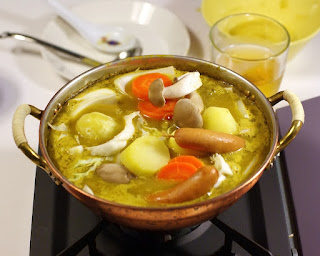I read many articles, follow many blogs and try to keep up with trends in my industry. Among the many articles and blogs I read are references to “food pilgrims”. And I began to think … am I a food pilgrim? Are you? Let’s see, what precisely is a food pilgrim? A pilgrim (lat. peregrinus) is one who undertakes a pilgrimage, literally 'far afield'. This is traditionally a visit to a place of some religious or historic significance; often a considerable distance is traveled. So a food pilgrim is one who seeks out a great/historic/life changing food experience? Perhaps it is just one who seeks travel destinations based on a cuisine or a particular restaurant or chef. I think this sounds right. If you ask Sage, who writes a blog @ foodpilgrimage.com you would get the 7 reasons to be a Food Pilgrim. She begins her list with “A Life of Passion”. Now that’s right up my alley. She explains, “Life is richer when each meal is transformed into the ultimate pursuit of pleasure.” Go Sage (funny quinki-dink, the etymology of her name), I could not agree more and perhaps this is the best aspect or greatest virtue to being a food pilgrim if in fact I am or should try to be.
But I cannot say with great conviction that I seek out a far destination solely based on a restaurant, a location that thrives on excellent food or even a particular chef for that matter. This year Peggy and I went to Old San Juan, Puerto Rice for vacation. We just love architecture and the Spanish culture. While I love Spanish food, this trip was not solely for this reason. I wanted the full Spanish-Caribbean experience; the beaches, the people, the music and of course the food. However, I did research out the best restaurants, most authentic places where locales go to eat prior to leaving on my journey. I go to Europe every chance I get but I do not seek a destination/city for a particular restaurant. But I would I guess if I had unlimited resources. But since so many other things motivate, thrill and bring serious joy and passion to my life, I can usually find many reasons to visit a city. Last time I was in Paris I did the same thing. But I did not go to Paris simply to eat at a particular café or restaurant. I went for the whole experience. Same goes for Vienna, Prague, Sevilla, Lisbon, Roma, Florenza, Amalfi, Porto, Siena, Lucca, Montalpucciano and many other cities I have visited in the past ten years. It was for the whole experience or sometimes to visit friends. But I always search out the places I want to eat with great enthusiasm and vigor. I will spend as much if not more time finding these places, making phone calls, sending emails etc ….than historic sights and historical information!
On the other hand, I will drive to Charleston, some 55 minutes for a great meal at a specific restaurant. Is this a “far afield”? I usually make the trip to Charleston because I have a special evening, an anniversary or birthday and thus want to go out of town. But sometimes it is to see what a Chef is doing that makes headlines. Like when McCrady’s chef Sean Brock won a James Beard Award, I went up to see what changes had been made to the restaurant and what foods they were doing. So, in a vague sense I maybe a food pilgrim.
Another reason Sage gives for aspiring to be a food pilgrim is #4; Quality over Quantity. She surmises, “Spending more time and more money on better food has the happy byproduct of forcing you to eat in reasonable quantities. Though nearly blasphemy in our “more-is-better” culture, with its “Gonna get ma’ money’s worth” mantra, eating less of a quality food will satiate your senses, and your spirit, not just your thymus and your belly.” Well, enough said, I am a Food Pilgrim! I not only have aspirations but a thriving appetite for quality food and I do seek out the best places to eat based on this new mantra! I have been wanting to make a pilgrimage to Phoenix, Arizona to visit Matt Bianco’s “Pizzeria Bianco”; heralded as the best pizza in America from EVERYONE I respect in our industry. So I guess I could be a food pilgrim. Would I be willing to travel to Phoenix just for some of Matt’s delicious pie? Probably not, but if I were near the area and it wasn’t that far a drive ... yes, I probably would go! Or, what a pilgrimage to a farm to get fresh produce or vegetables .. isn't this a pilgrimage? I think so.
There is another reason I took notice of this trend. My Gastro-pub is somewhat of a journey, albeit only 15 minutes from downtown Beaufort, but to many considerably further. The thought that reached out to me was how important it is to find out from our patrons … did they journey far to be with us? Are we the kind of place people will consider making a food pilgrimage? This thought, and question has me hoping to be, and hoping you are also …. Not just a passionate person about food but one who seeks out specials places to enjoy a meal and friends. Cheers!









